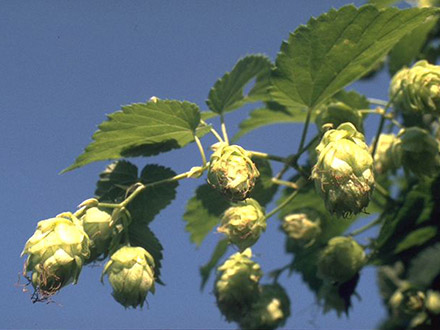Botanical name
(Common) Hops - Humulus lupulus L.
Family
Cannabaceae
Common name
Hops, Common hops
Information about the plant
Hops has been cultivated for brewing beer in Central Europe since the 8th century and is now cultivated in all temperate zones. It gives beer its bitterness. It is unclear where it originally came from, because its prolonged farming has contributed to its spread far beyond the original area, and no fossil deposits have been found. In Germany, it is often found growing wild on riverbanks and in riparian forests. The female plant is cultivated, as only the "hop cones" are used as beer wort. Numerous cultivated forms are known.
The genus name Humulus is probably a Latinization of the Germanic name for hops, "lupulus" is the diminutive form of the Latin "lupus" (= wolf), "because the climbing plant brings harm to other plants like the wolf to other animals." There are several explanations for the origin of the German name, possibly referring to the female flower cones, which look like "tassels" (Norwegian 'hupp', Swiss 'Huppen' = tassel).
Hops is a perennial, twining vine whose shoots grow 6 m long in a year, and even up to 12 m when cultivated. The leaves are opposite and are usually divided into 3 to 5 toothed, long-pointed lobes. The plant is dioecious, i.e. there are plants with male and plants with female flowers. Typically, the female flowers look like cones ("hops") and grow together densely in pseudo-spikes. The cone-shaped appearance is a result of many ovate bracts, about 1.5 cm long, overlapping like "roof tiles". There are two bracts in each of the axils, and the inconspicuous flowers are at their base. The inside of the bracts is covered with small, shiny, pale yellow glandular scales (hop glands). The flowering time is in July/August.
Medicinally used parts of plants (herbal drug)
The dried female inflorescences (hop cones) are used. The drug comes from southern Germany and the Czech Republic, and imports from the USA and China.
Constituents of the herbal drug
Hop cones contain hop resins consisting of bitter phloroglucinol derivatives (hop bitters), and essential oil.
Quality of the drug
The quality of hops (Lupuli flos) is specified in the European Pharmacopoeia (Ph. Eur.).
Medical applications
Recognised medical use
The HMPC has classified hop cones as a traditional herbal medicinal product (see "Traditional use"). A combination of hops and valerian root in the form of dry extracts with the indication "for the improvement of sleep disorders" was accepted by the HMPC as "well established use".
ESCOP: for nervousness, restlessness, and sleep disorders.
Traditional use
Hop cones and several combinations of hops and valerian root have been classified by the HMPC as a traditional herbal medicinal product (Article 16a of Directive2001/83/EC). Based on long-standing use, hop cones or hop cone/valerian preparations can be used for relief of mild symptoms of mental stress and to aid sleep.
Herbal drug preparations in finished dosage forms
- Cut drug to prepare tea
- Dried extract in tablets, capsules and coated tablets
- Humulus lupulus homeopathic mother tincture in drops
Dosage
Prepared drugs: see patient information leaflet.
Tea infusion: drink a cup of warm hops tea several times a day; as a sleep aid half an hour before bedtime. Single dose: 0.5 -1 g of the drug.
It is useful to combine it with other drugs such as valerian root, passionflower herb and lemon balm leaves (sleeping and calming teas).
Preparation of a tea
Pour 150 ml of boiling water over 0.5g -1 g (2-4 tsp) of crushed hops and strain after 2 to 3 hours.
Notes
It is not entirely ruled out that hop impairs the ability to drive.
An intake of hops during pregnancy and lactation is not recommended because there are no safety studies available. Likewise, there is no evidence for its use in children and adolescents under 12 years old.
Side effects
None known.
Interactions
None known.
References
Herbal drug monographs
HMPC (2014), ESCOP (2003), WHO Vol. 3
Further literature
Commentary on the European Pharmacopoeia (Hop cones, Nr. 1222)


